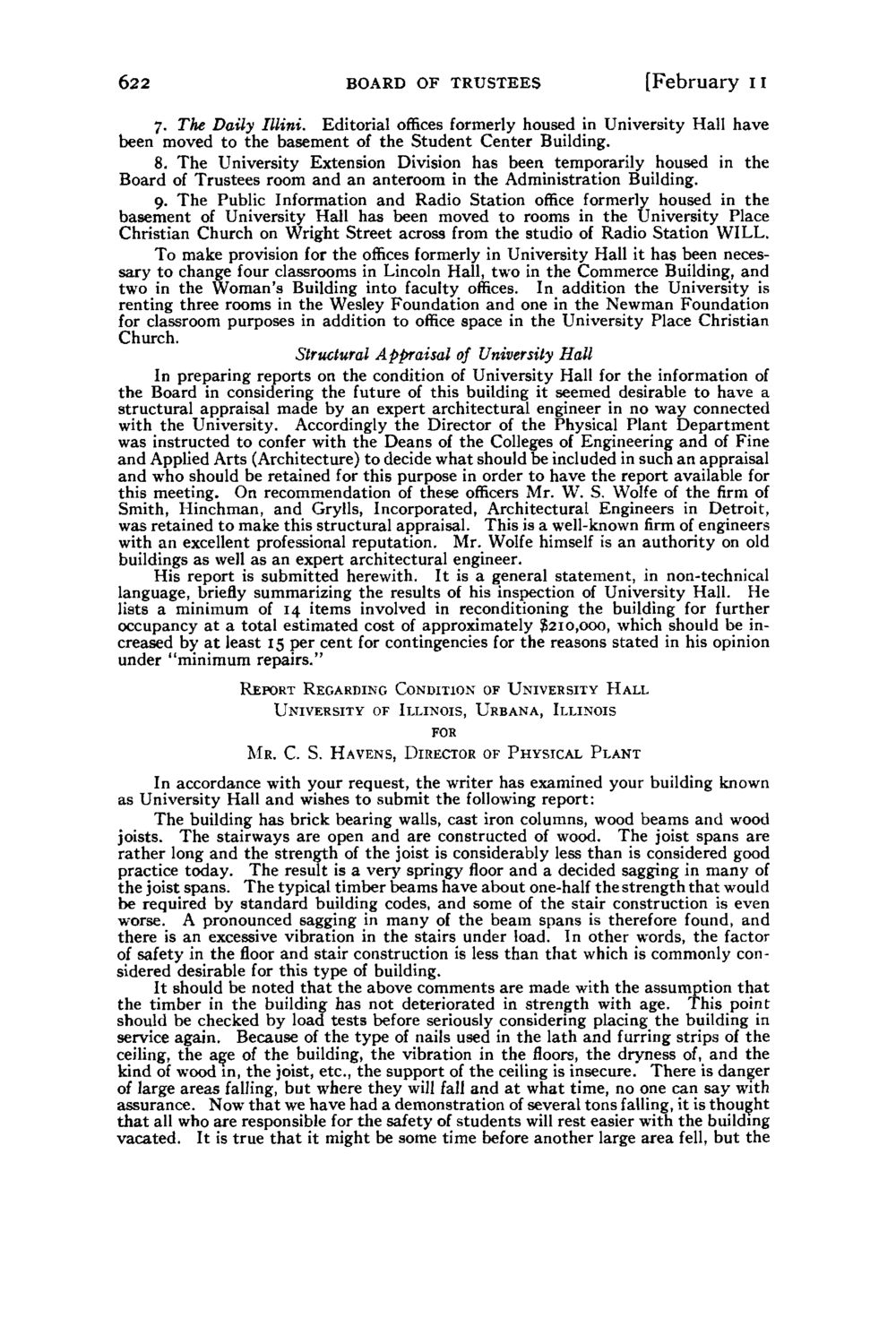| |
| |
Caption: Board of Trustees Minutes - 1938
This is a reduced-resolution page image for fast online browsing.

EXTRACTED TEXT FROM PAGE:
622 BOARD OF TRUSTEES [February 11 7. The Daily Mini. Editorial offices formerly housed in University Hall have been moved to the basement of the Student Center Building. 8. The University Extension Division has been temporarily housed in the Board of Trustees room and an anteroom in the Administration Building. 9. The Public Information and Radio Station office formerly housed in the basement of University Hall has been moved to rooms in the University Place Christian Church on Wright Street across from the studio of Radio Station WILL. To make provision for the offices formerly in University Hall it has been necessary to change four classrooms in Lincoln Hall, two in the Commerce Building, and two in the Woman's Building into faculty offices. In addition the University is renting three rooms in the Wesley Foundation and one in the Newman Foundation for classroom purposes in addition to office space in the University Place Christian Church. Structural Appraisal of University Hall In preparing reports on the condition of University Hall for the information of the Board in considering the future of this building it seemed desirable to have a structural appraisal made by an expert architectural engineer in no way connected with the University. Accordingly the Director of the Physical Plant Department was instructed to confer with the Deans of the Colleges of Engineering and of Fine and Applied Arts (Architecture) to decide what should be included in such an appraisal and who should be retained for this purpose in order to have the report available for this meeting. On recommendation of these officers Mr. W. S. Wolfe of the firm of Smith, Hinchman, and Grylls, Incorporated, Architectural Engineers in Detroit, was retained to make this structural appraisal. This is a well-known firm of engineers with an excellent professional reputation. Mr. Wolfe himself is an authority on old buildings as well as an expert architectural engineer. His report is submitted herewith. It is a general statement, in non-technical language, briefly summarizing the results of his inspection of University Hall. He lists a minimum of 14 items involved in reconditioning the building for further occupancy at a total estimated cost of approximately $210,000, which should be increased by a t least 15 per cent for contingencies for the reasons stated in his opinion under "minimum repairs." REPORT REGARDING CONDITION OF UNIVERSITY H A L L UNIVERSITY OF ILLINOIS, URBANA, ILLINOIS FOR M R . C. S. H A V E N S , DIRECTOR OF PHYSICAL P L A N T In accordance with your request, the writer has examined your building known as University Hall and wishes to submit the following report: The building has brick bearing walls, cast iron columns, wood beams and wood joists. The stairways are open and are constructed of wood. The joist spans are rather long and the strength of the joist is considerably less than is considered good practice today. The result is a very springy floor and a decided sagging in many of the joist spans. The typical timber beams have about one-half the strength that would be required by standard building codes, and some of the stair construction is even worse. A pronounced sagging in many of the beam spans is therefore found, and there is an excessive vibration in the stairs under load. In other words, the factor of safety in the floor and stair construction is less than that which is commonly considered desirable for this type of building. It should be noted that the above comments are made with the assumption t h a t the timber in the building has not deteriorated in strength with age. This point should be checked by load tests before seriously considering placing the building in service again. Because of the type of nails used in the lath and furring strips of the ceiling, the age of the building, the vibration in the floors, the dryness of, and the kind of wood in, the joist, etc., the support of the ceiling is insecure. There is danger of large areas falling, but where they will fall and a t what time, no one can say with assurance. Now t h a t we have had a demonstration of several tons falling, it is thought that all who are responsible for the safety of students will rest easier with the building vacated. It is true that it might be some time before another large area fell, but the
| |